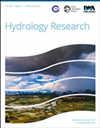Application of GIS and remote sensing in morphometric analysis of river basin at the south-western part of great Ganges delta, Bangladesh
IF 2.4
4区 环境科学与生态学
Q2 Environmental Science
引用次数: 2
Abstract
Analysing the morphometric parameters is the most expedient and parsimonious way of representing the hydrologic and physiographic attributes of river basins. The present study attempts to measure the morphometric parameters for assessing the understanding of morphological, hydrological, and physiographic properties of the south-western part of Ganges delta. Parameters were analysed from Shuttle Radar Topography Mission's (SRTM) maps and total of eight linear, six areal, eight relief, and five drainage texture parameters have taken with hypsometric analysis for the four major rivers and two tributary river basins. The values of linear parameter denote that most of the streams (82%) fall in first order, and other orders have homogeneous underline materials. The aerial parameters represent low peak discharge and the upper region is less vulnerable to flood. The relief parameter values show that the entire basin has low surface runoff and they are less erosional (slope < 3.97°). The drainage density indicates the coarser nature and circularity ratio (0.08) represents the elongated shape. The southern portion of the basin has a greater flood potential and hypsometric index (0.49) shows the entire basin is in mature stage of formation. These results would be helpful for reckoning the watersheds for drainage management and environmental planning for ecological management and sustainable development.GIS与遥感在孟加拉恒河三角洲西南部流域形态分析中的应用
分析形态计量参数是表征流域水文地理属性最方便、最简洁的方法。本研究试图测量形态测量参数,以评估对恒河三角洲西南部形态、水文和地理特征的理解。利用航天飞机雷达地形图(SRTM)对4条主要河流和2条支流流域的8个线性、6个平面、8个地形和5个流域纹理参数进行了剖分分析。线性参数的值表明,大部分流(82%)为一阶流,其他阶流具有均匀的底层材料。航空参数表现为低洪峰流量,上部区域不易受洪水影响。地形参数值表明,整个流域地表径流量较小,侵蚀性较小(坡度< 3.97°)。疏水密度代表较粗的性质,圆度比(0.08)代表拉长的形状。盆地南部洪水潜力较大,低压指数(0.49)表明整个盆地处于成熟地层阶段。这些结果将有助于流域的估算和排水管理,有助于生态管理和可持续发展的环境规划。
本文章由计算机程序翻译,如有差异,请以英文原文为准。
求助全文
约1分钟内获得全文
求助全文
来源期刊

Hydrology Research
Environmental Science-Water Science and Technology
CiteScore
5.30
自引率
7.40%
发文量
70
审稿时长
17 weeks
期刊介绍:
Hydrology Research provides international coverage on all aspects of hydrology in its widest sense, and welcomes the submission of papers from across the subject. While emphasis is placed on studies of the hydrological cycle, the Journal also covers the physics and chemistry of water. Hydrology Research is intended to be a link between basic hydrological research and the practical application of scientific results within the broad field of water management.
 求助内容:
求助内容: 应助结果提醒方式:
应助结果提醒方式:


